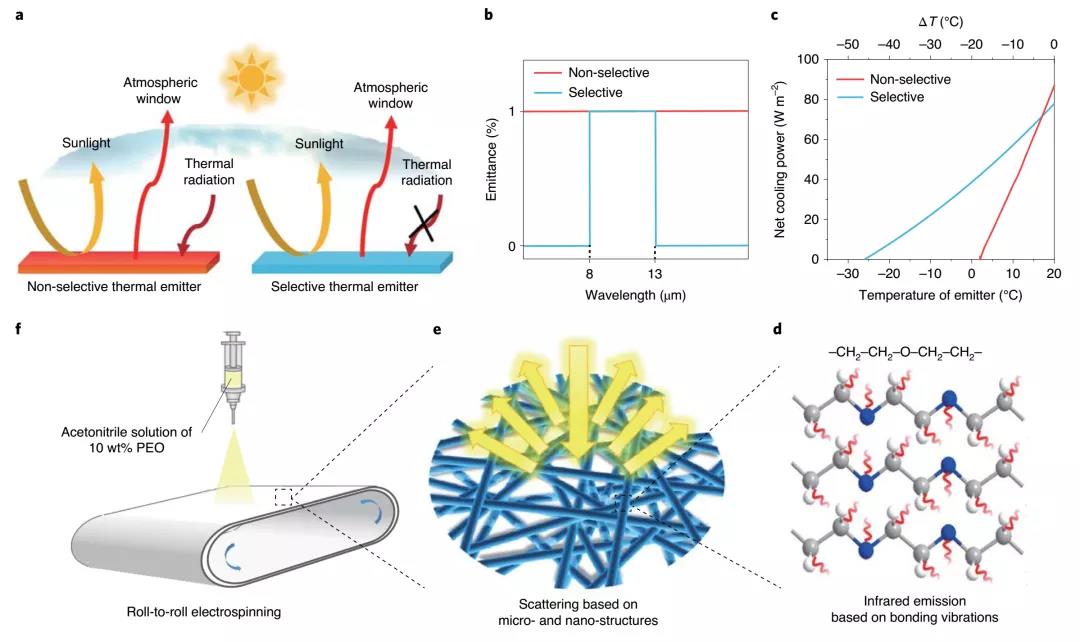
hotline:
17715390137
Tel/Wechat:
18101240246 (Technology)
0512-68565571
Email:mxenes@163.com (Sales Engineer)bkxc.bonnie@gmail.com
Scan the code to follow or search the official account on WeChat:
2D Materials Fronrier After paying attention,
click on the lower right corner to contact us,
Enter enterprise WeChat.
Professional Services Online


First author: Duo Li, Xin Liu, Wei Li.
Corresponding authors: Zhu Jia, Zhu Bin
Communication unit: Nanjing University
Conventional cooling systems generate enormous energy consumption, which contributes greatly to the greenhouse effect. Passive radiation cooling technology, which dissipates heat from objects into outer space through atmospheric transparent Windows (8 -- 13 m) without any energy consumption, has attracted wide attention in recent years.
Radiative cooling is unique in its high emissivity in the transparent window of the atmosphere through which heat can be emitted into space. Therefore, in order to achieve high cooling performance, the design and manufacture of selective transmitters are crucial, in which emission dominates in transparent Windows, and appropriate spectral selection can inhibit parasitic absorption of surrounding thermal radiation. Recently, a variety of materials and structures with customized spectral responses have been studied to achieve the effect of radiation cooling during the day. However, most of the radiation-cooled materials reported have broadband absorption/emission covering the entire mid-infrared wavelength and are not selective.
Because emission in the mid-infrared region is usually associated with molecular bonding, molecule-level designs with appropriate chemical bonding provide a more convenient and scalable approach to narrow band and selective absorption/emission of the mid-infrared region for radiation cooling compared to complex top-down fabrication.
In view of this, Zhu Jia and Zhu Bin et al. from Nanjing University reported a graded polymer nanofiber film that can achieve selective mid-infrared emission, effective sunlight reflection, and excellent all-day radiation cooling performance.

FIG. 1. Design principles
Point 1. Principle
In all the polymer films, only the c-C, C-O and C-H bonds of polyoxyethylene (PEO) have an ideal selective absorption band and overlap with the atmospheric transparent window (8 -- 13 m). The selective emissivity of c-O-C bonding (1260-1110 cm-1) and C-OH bonding (1239-1030 cm-1) was 78% in the range of 8-13 m, and the reflectivity of the nanofibers with controlled diameters was 96.3% in the range of 0.3-2.5 m.
Point 2. Performance
The results show that the cooling performance of the selective heat emitter improves by about 3°C compared with the non-selective heat emitter at night. Even in sunlight, the temperature drops by 5°C.

Figure 2. Structure of ES-PEO

FIG. 3. Cooling effect of ES-PEO film
Point 3. Suitable for large-scale manufacturing process
From the above data, in addition to the selective emission of heat in the atmospheric transparent window (8 -- 13 m), a strong reflection of the solar spectrum (0.3 -- 2.5 m) is required for high performance all-day radiation cooling.
However, the typical PEO film prepared by drop casting is visually transparent and cannot meet the requirement of high sunlight reflectivity. The nanofibers with a diameter equal to the wavelength of the solar spectrum can be used as effective scatterers to achieve strong solar reflection.
Therefore, the researchers developed an improved roll-to-roll electrostatic spinning method based on extensible electrostatic spinning process production, and synthesized layered PEO thin films composed of random nanofibers for use in daytime radiation coolers.
This electrostatically spun PEO (ES-PEO) film is several meters long, a quarter of a meter wide and 500 m thick. Its white color represents a strong scattering of visible light due to the multi-layered structure of irregular stacked nanofibers with a wide distribution of diameters.

FIG. 4. Simulation of cooling effect
summary
This layered design of selective heat radiator has shown significant advantages in mitigating the effects of earth warming and regulating the temperature of Earth-like planets. With its excellent cooling performance and extensible process, this layered design of selective heat radiator opens a new way for large-scale applications of all-weather radiation cooling materials.
References:
Li, D., Liu, X., Li, W. et al. Scalable and hierarchically designed polymer film as a selective thermal emitter for high-performance all-day radiative cooling. Nat. Nanotechnol. (2020).
DOI: 10.1038 / s41565-020-00800-4
https://doi.org/10.1038/s41565-020-00800-4

| Reminder: Beijing Beike New Material Technology Co., Ltd. supplies products only for scientific research, not for humans |
| All rights reserved © 2019 beijing beike new material Technology Co., Ltd 京ICP备16054715-2号 |